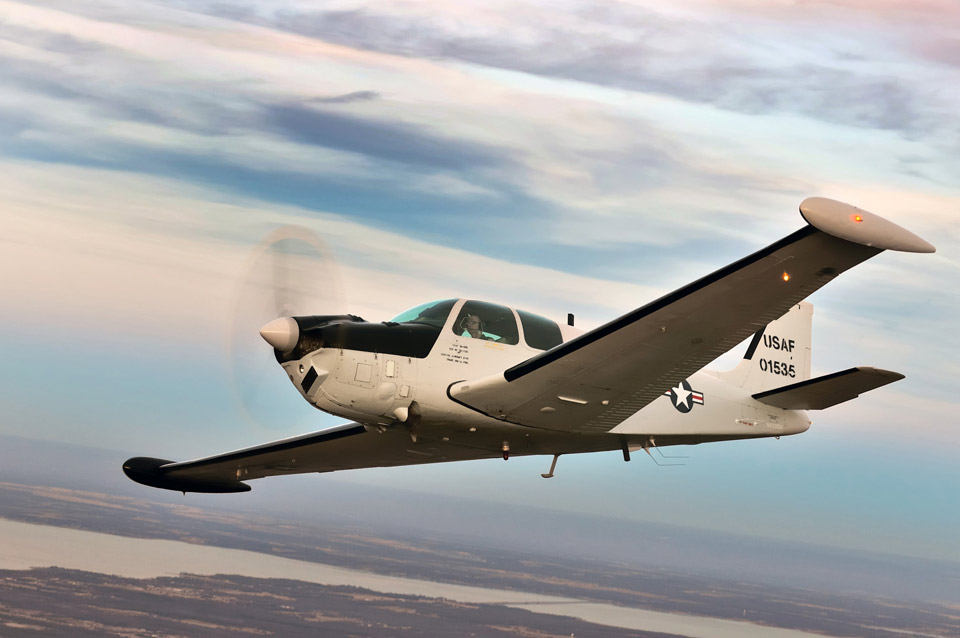
At 25,000 feet, the small gray airplane was barely a speck in the sky above Southeast Asia. At dusk or dawn, at night, or in clouds, it would have been invisible. This was no F–4 Phantom or OV–10 Bronco. Few students of the Vietnam War know much about the QU–22B Pave Eagle, the most unusual Bonanza you’ve never seen. Well, it’s mostly Bonanza; the highly modified airframe has a number of unique parts. Only 27 were built, plus six predecessor YQU–22A models. Just a handful exist on the civilian registry today and two are known to be flying.
The reunions
After the war, “we were sworn to secrecy, and nobody knew A to Z—the whole program. You just kept your mouth shut and went about your business,” said Clagett, who thought all the QU–22s were scrapped in Southeast Asia. “When I saw this aircraft for the first time after 41 years, the emotion just overwhelmed me. I just couldn’t talk. I could just stare at that airplane and all of these memories came flooding back.”
“For years I had wondered whether my memories of how close we were, and how we got along…were not colored by looking through rose-colored glasses,” Martine said. The 2013 reunion told him he was not mistaken. “There is a bond there.”
The Vampires are organizing their second reunion for October 2 through 5, 2014, in Dayton, Ohio (www.qu-22reunion.com). Plans call for the Studers’ QU–22B to be joined by another example from New Jersey.
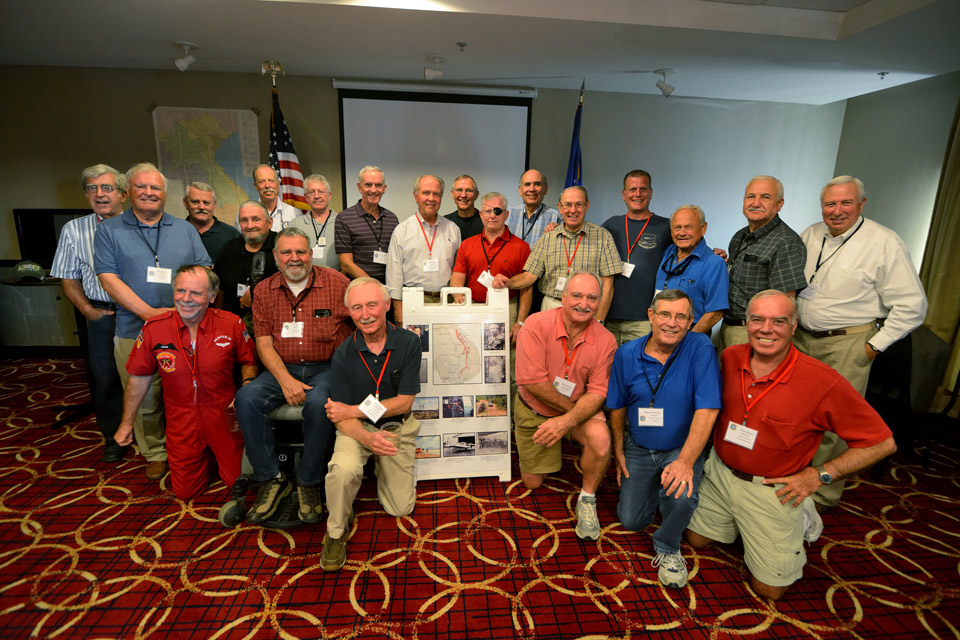
Many of the men who flew the QU–22B during the Vietnam War gathered last fall in Midland, Texas, for the first time in more than 40 years. Not only was it their first reunion, but many were meeting for the first time, because some pilots had rotated out of the squadron before newer arrivals cycled in. The event led to plans for a second reunion, which will be held October 2 through 5, 2014, in Dayton.
Email [email protected]
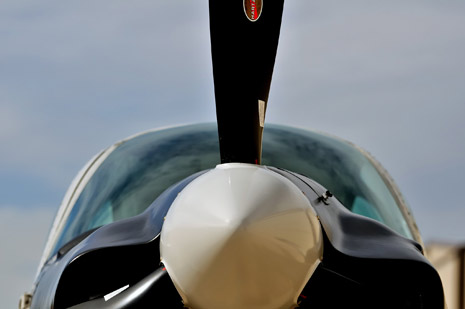

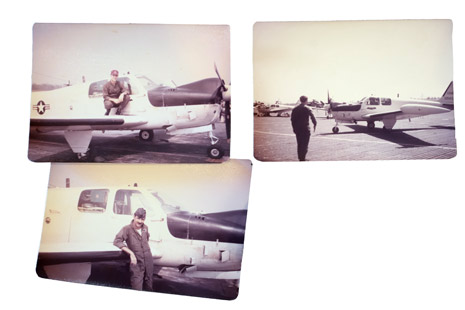
The Studer family of Dallas has restored one of those. Starting at the front, the prop combines Mitsubishi MU–2 blades in a custom hub, Brian Studer said. “The engine is a GTSIO-520-G. Continental doesn’t even have any records on the engine. They believe the camshaft is different and the crankshaft is different.” Pilots who flew the airplane in Vietnam said the AiResearch turbocharger made full manifold pressure to approximately 20,000 feet, he said, but “AiResearch said it belonged on a semi truck, not on an airplane.”
The engine cowling has a pronounced hump on the top, which Studer said was to accommodate the QU’s oversized generator and ingest more cooling air. That actually led to significant overheating problems in Vietnam, because the cowl flaps could not exhaust all that air fast enough. With the generator removed, the cowling has been cut down on the Studers’ airplane. “I’ve got an original one coming,” he said. “I don’t have any overheat problems at all with the cut-down cowling.”
The wing, wing spar, and landing gear come from the Beech Baron, although tire and strut pressures are higher because of the QU–22’s weight. The Studers use 5,000 pounds as a maximum gross weight, although a pilot’s operating handbook allows 5,800 pounds. “In Vietnam they were routinely operating them at 6,400 pounds.” Studer said. Today’s Bonanza G36 has a 3,650-pound maximum takeoff weight. Including tip tanks, the QU–22 carries 220 gallons of useable fuel—almost three times a G36’s 74 gallons.
The Studers’ QU–22B was the centerpiece last fall of the first reunion of its pilots since they left Nakhon Phanom, Thailand (dubbed NKP), 41 years ago. Thirty-seven men from the U.S. Air Force’s 554th Reconnaissance Squadron—call sign Vampire, because they mainly flew at night—and from Detachment 1 of the 553rd Reconnaissance Wing, which flew the earlier QU–22A, gathered in Midland, Texas, last October during the Commemorative Air Force’s annual Airsho.The missions
“The QU was designed to be a monitor relay station,” explained Jim Brightbill of Fort Worth, Texas, who logged about 705 hours in the QU–22 from fall 1970 to fall 1971. “They [air-dropped] seismic sensors in along the [Ho Chi Minh] Trail, and a few acoustic sensors that hung up in the trees, and those were line-of-sight transmissions.” The airplane was an airborne radio repeater, flying a racetrack pattern at 20,000 to 25,000 feet and relaying transmissions from those sensors to a monitoring station in Thailand, code-named Blue Chip. “We had a few real-time strikes called in from our information, but for the most part it was intelligence gathering,” he said.
When Ken Clagett of Henderson, Nevada, arrived at NKP, seasoned squadron members took him under their wing. “They taught us really what the mission was. Because so much of this stuff was secret, they didn’t tell you a lot…if we didn’t know, we couldn’t share it with anybody else. We were sworn to secrecy.”
The Q stands for unmanned, and U stands for utility, Clagett said. The QU–22 was intended to be a drone, and sometimes was flown remotely. “It just never was practical to do it in the actual theater, so it was always flown by pilots when we were on a mission.” But the knowledge gained contributed to development of the Predator and other highly sophisticated unmanned aircraft of today. “They can be halfway around the world, with cameras, watching live footage. It’s pretty phenomenal. This aircraft laid the foundation for what we have today.”
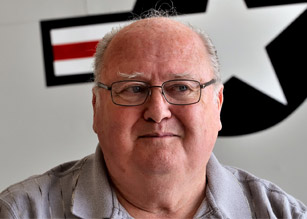
“One of the neat features of the airplane was they had music—you could tune to a channel and listen to music over your headset.”
—Louis Pucilowski

“So much of this stuff was secret. They didn’t tell you a lot...if we didn’t know, we couldn’t share it with anyone else.”
—Ken Clagett
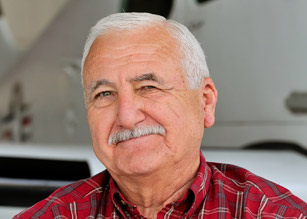
“These guys would bring a big black box out. They had it manacled to their wrists—they were spooks, I guess.”
—D.L. Martine
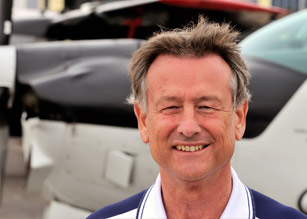
“We had a few real-time strikes called in from our information, but for the most part it was intelligence gathering.”
—Jim Brightbill
After taking off from NKP and climbing to altitude, the mission involved flying along the Ho Chi Minh Trail or around the demilitarized zone (DMZ), a dividing line between North and South Vietnam. “You stayed up there for about five hours, doing a racetrack pattern,” said Louis Pucilowski of Fort Worth, Texas; the return to NKP made a normal mission about 6.3 hours.
“Aircraft engine failure concerns and weather were the two biggest concerns,” said Pucilowski, who flew B–52s before and after the QU–22. No aircraft were lost to ground fire, “but we lost several to weather, and we had several engine failures.” Six QU–22Bs were lost in Vietnam—four because of engine failures—and two pilots were killed.
“And then we got another mission,” said D.L. Martine of Henderson, Texas. “These guys would bring a big black box out. They had it manacled to their wrists—they were spooks, I guess.” The box would be installed and connected in place of the regular radios, and the pilot would fly down the middle of Laos, paralleling the Mekong River to Cambodia.
In this mission, Compass Flag, the QU–22B carried a multi-user radio receiver downlinked to the 6908th Security Squadron at NKP. There, trained Vietnamese linguists operated 15 radio intercept positions. “The quality and quantity of intelligence data resulting from the QU–22B Compass Flag mission was superb,” said Paul Bernard, who served with the 6908th. “The main target of Compass Flag was the NVA GDRS—General Directorate of Rear Services. This was the command responsible for the movement of troops and supplies on the Ho Chi Minh Trail.”
Later, a four-engine EC–130 replaced the QU–22B on this mission. “The QU–22B broke the ground on this remote-receiving technology—25,000 feet, single pilot, single-engine, unpressurized, no weather radar, IFR over hostile territory. Now that is one hell of a tough mission,” Bernard said.
The men
Life at NKP was pretty good, Pucilowski said. The pilots had air-conditioned hooches, or quarters. “I happened to tap into the base phone line, so I jury-rigged a phone into my hooch, where I was able to call my wife on the HF radio.”
He would pass the time on orbit by reading. “Most of the time I read a book a mission. One of the neat features of the airplane was they had music—you could tune to a channel and listen to music over your headset. It made the time go by.” With the pattern programmed into the autopilot, all the pilot had to do was correct for wind drift and monitor.
Takeoffs in the airplane could be scary, he added. “The takeoff roll would roll, and roll, and roll, and finally it would lift off the ground.” The large hump on the cowl made climbing out a challenge; it blocked the pilot’s view and induced vertigo. “I know I got vertigo quite a bit over there. The only thing that saved me was the autopilot.”
“NKP, including flying, was the most fun I ever had in the Air Force,” Martine said. “We were very close. Our squadron commander did a great job of keeping up the camaraderie.” They often played volleyball, pilots versus maintenance guys. “We had a party hooch, we had full-time, 24-hours-a-day Thai bartenders. There was always something to do.”
On missions Martine read, worked crossword puzzles, and listened to the music. Sometimes he would talk with a ground controller in Quang Tri, Vietnam. “He was bored silly most of the time at night, and he’d be happy to talk to you if you wanted to talk.”
One night, Brightbill fell asleep on orbit. “It was pitch dark when I fell asleep and when I woke up, the sun was up, and I was scared to death that I would run out of fuel and not make it back to the base. I looked at my watch and I’d only been asleep for 15 minutes, so it didn’t affect my mission.”
Weather and mechanical
“The weather would pop up so fast—you could see it while you were flying.” Pucilowski said. “It would be a beautiful day, and those thunderstorms would come up over 35,000 feet in the matter of an hour. Then you’d see a line of thunderstorms between you and NKP, and you’d wonder how you were going to get home.
“We were always concerned about thunderstorms, flying into a cloud with no radar or any ability to tell if we were flying into a big cell or not.” Pucilowski was caught in a thunderstorm once. “I was flying at 25,000 feet and it kicked me up to 30,000 feet in just a couple of seconds.”
Just as he was lifting off one night, both of Brightbill’s magnetos momentarily shorted out—then they did it again. “That scared the living daylights out of me. To get out of that airplane, you had to reach over, pull a door release, push the door off, unstrap, crawl out on the wing, and jump off. There were 100-foot trees out there, and it was pitch dark.” He declared an emergency and returned to base.
“One night I was on orbit, and I got a call from another pilot who was coming up to relieve me. He says, ‘Jim, I lost my engine, I got it restarted but it’s running rough.’ And I got scared, thinking of the whole situation,” Brightbill said. “I joined up with him and flew back to the base to make sure he got there, and then I flew back up to the mission until they could get another plane up there to replace me. But I was amazed that I could get so scared over his emergency.”
At 15,000 feet on one climbout, Martine noticed his manifold pressure had dropped. “I pushed the throttle in a little bit and it came back, then it immediately started going down again. Then I did a very dumb thing—I reached up and pushed it in all the way, and it kind of went ‘poof,’ the cockpit filled up with smoke and the engine quit.” A leaking turbocharger duct ruptured and caused an electrical fire, taking out the radios. “I tried several times to start the engine. I could see NKP but I wasn’t going to make it.” His third restart attempt, at about 10,000 feet, was successful.



